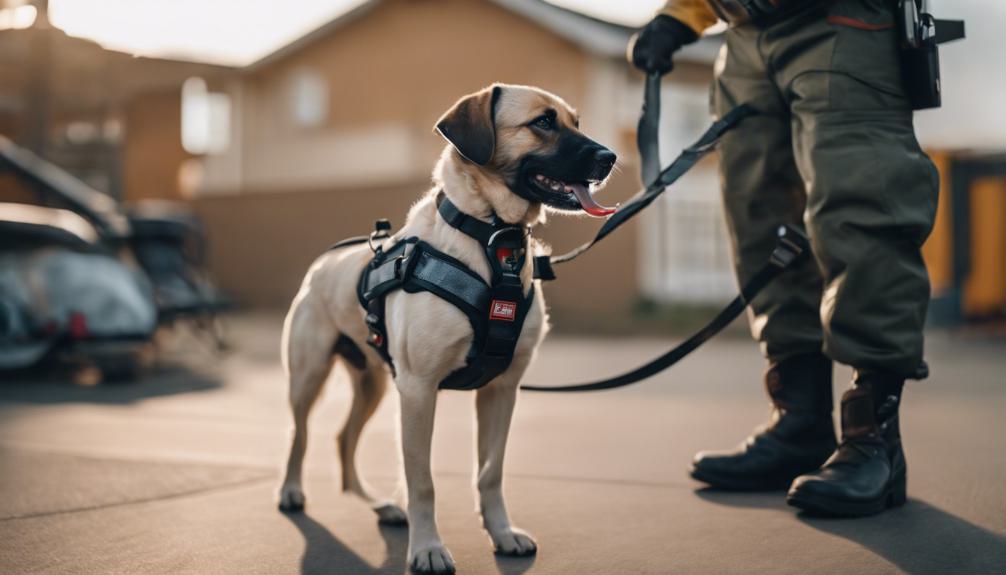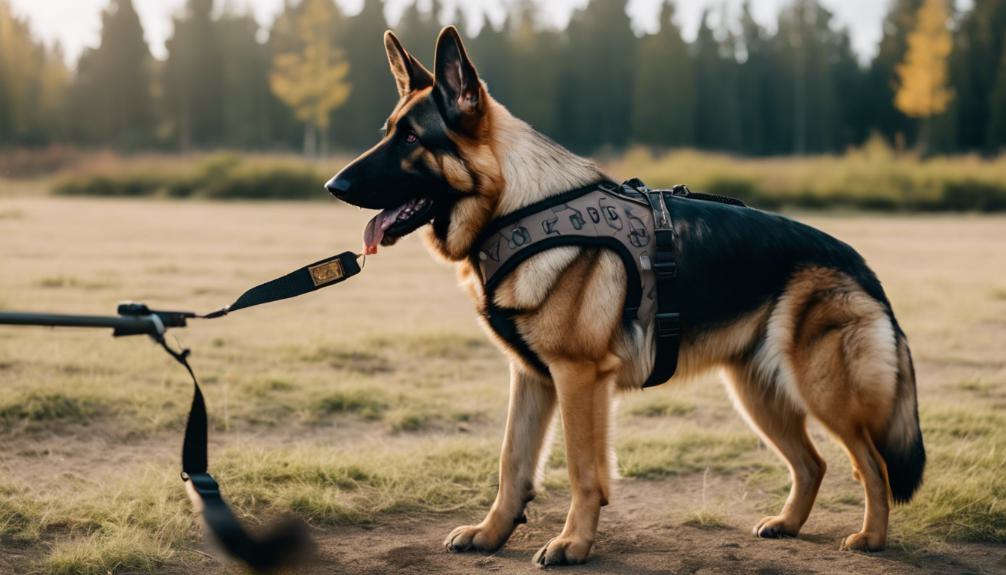How to Train a Dog for Bite Work? Insider’s Training Manual
To train your dog for bite work, start early to develop foundational skills. Evaluate breed suitability and engage in obedience training. Select proper training equipment like quality harnesses and bite sleeves. Work with a skilled helper to guide you through exercises. Teach control using consistent commands and reward discipline. Manage stress by gradually exposing your dog to challenges. Commit to lifelong training for sharp skills. Showing dedication guarantees continued enhancement. There are more strategies to explore for effective bite work training to maximize your dog’s potential.
Understanding Dog Drives for Bite Work
Understand the dog’s motivations for bite work to train successful protection dogs. Knowing the key dog drives, such as prey, defensive, and fight drive, is crucial. Prey drive starts early in puppies, around 6 weeks old, and is key for teaching them how to bite correctly in protection work.
Defensive drive kicks in when a dog feels threatened, combining with other drives to trigger the right responses. Fight drive, developed with proper training, prepares the dog to confront challenges during bite work. Manage avoidance, the natural instinct to dodge threats, using methods like desensitization and positive reinforcement.
During training, the helper’s role evolves. Initially, the dog may view the helper as a threat, but over time, sees them as a sparring partner, which boosts the dog’s confidence and bite work skills.
Preparing for Bite Work Training
To start bite work training, first evaluate if your dog is suitable. Look at their breed, behavior, confidence, and drive. Make sure your dog has completed obedience training and has been well-socialized. This forms a strong base. Also, check your dog’s prey drive, stress levels, and confidence to see if they’re ready for this type of training.
Keep these important points in mind:
- Breed: Some breeds, like German Shepherds, Dobermans, and Belgian Malinois, have natural tendencies for protection work.
- Confidence Level: Dogs that are confident are more capable of handling the challenges of bite work training.
- Prey Drive: High prey drive can indicate a good candidate for protection training. Dogs like this enjoy chasing and capturing, making them potentially good at protection tasks.
This approach ensures that your dog is prepared and suited for the demands of bite work training.
Selecting the Right Training Equipment

When selecting training equipment for bite work, focus on safety and functionality for you and your dog. Choose a high-quality agitation harness for better control and comfort. Use a sturdy collar and leash to ensure a secure connection with your dog. Employ a long line for greater safety and control during training. Invest in quality bite sleeves to protect the trainer and mimic real-life situations. Include reward toys to encourage your dog through positive reinforcement.
Here’s a summary of the essential training equipment:
| Equipment | Description |
|---|---|
| Agitation Harness | Provides control and adds comfort. |
| Durable Collar | Ensures a secure connection. |
| Leash | Helps maintain control during training. |
| Long Line | Offers extra safety and control. |
This list covers the basics needed for effective and safe training, ensuring a positive experience for both you and your dog.
Starting Bite Work Training Early
Initiate bite work training around 8 weeks old to establish a strong base for your dog’s growth and abilities. Factors like breed, personality, confidence, and prey drive are crucial in deciding when to start. Dogs that naturally chase or have a strong desire to pursue often excel in this training. Here are the benefits of starting early:
- Enhance Development: Begin training early to foster the growth of vital skills.
- Smooth Progression: Early lessons pave the way for easier advancement in more complex training later.
- Leverage Expertise: Engage skilled trainers from the start to provide your dog with expert guidance and instruction.
This approach ensures that your dog learns the right skills from the beginning, making future training more effective and enjoyable.
Working With a Qualified Helper

Choose a qualified helper with the right experience and equipment for bite work training. These helpers are crucial for training police dogs, protection dogs, and working dogs like the German Shepherd. They use specific tools such as bite suits, sleeves, agitation harnesses, collars, leashes, and reward toys. These ensure the dog’s safety and the effectiveness of the training.
Helpers guide dogs through exercises that build their biting skills, which are essential for their roles. By choosing a skilled helper, you ensure your dog gets the proper training for success.
Teaching Control and Impulse Management
To teach your dog control and impulse management during bite work training, focus on their ability to obey commands before acting. This skill is crucial for a protection dog in high-stress situations. Follow these practical strategies:
Use Clear Commands:
Always employ the same words and gestures to tell your dog when to start. For example, say ‘Attack’ with a forward hand motion.
Build Patience:
Start with short waiting periods and slowly extend them. This teaches the dog to endure longer times before reacting.
Reward Discipline:
Give your dog treats and praise for waiting for your signal. This reinforces good behavior and encourages them to repeat it.
Managing Stress and Focus in Training

Start by slowly introducing the dog to increasingly challenging situations. Training requires both patience and consistent effort. Reward the dog with treats or praise when it stays focused and engaged during bite work sessions.
Include play breaks to reduce stress and keep your dog interested. Follow structured routines and use clear cues so the dog knows what to expect; this lowers stress.
Watch the dog’s body language for signs of stress or distraction. If you notice any, change your training approach to keep the environment positive and focused. By effectively managing stress and using positive reinforcement, your dog will have a better chance of succeeding in bite work training.
Ensuring Lifelong Commitment to Training
Maintain lifelong dedication to training to ensure your dog’s bite work skills stay sharp. As dogs grow, their hunting instincts and focus can change. Regular and structured training is crucial. Here are practical steps to commit to lifelong bite work training:
Incorporate Training Daily: Include training in your dog’s daily routine to consistently bolster bite work skills.
Establish a Solid Base: Start with basic training to create a strong foundation for more complex skills later on.
Reinforce Skills Regularly: Keep practicing to avoid skill loss and keep your dog sharp.
Each step is designed to build on the previous one, forming a comprehensive training routine that adapts as your dog ages.
Frequently Asked Questions
Can I Train My Dog in Bite Work?
You can train your dog in bite work with proper guidance, assessment of temperament, and working with a qualified trainer. It’s essential to have a structured plan, use positive reinforcement, and dedicate consistent practice for success.
How Do You Teach a Dog to Bite Control?
Start with developing prey drive using tug-of-war games. Progress to bite pillows, then sleeves. Incorporate obedience training for bite control. Consistent reinforcement and positive rewards are key. Equip properly for safety and effectiveness in training sessions.
What Are the First Steps of Bite Training?
To start bite training, establish obedience and socialization, acquaint bite equipment gradually, and begin with prey drive exercises. Use positive reinforcement and clear communication to lay the groundwork. Build confidence and interest in the training process.
Can Any Breed Do Bite Work?
Any breed can participate in bite work for fun and exercise, but for serious protection work, breeds like German Shepherds, Belgian Malinois, and Rottweilers are preferred due to their drive, courage, and trainability.
Conclusion
Master the basics of bite work training by always prioritizing safety and proper techniques. With commitment, patience, and expert guidance, your dog can learn essential skills for effective bite work.
Practice regularly and maintain consistency to enhance your dog’s performance. Training is a continuous process that demands ongoing dedication.
Wishing you success in your training efforts!

